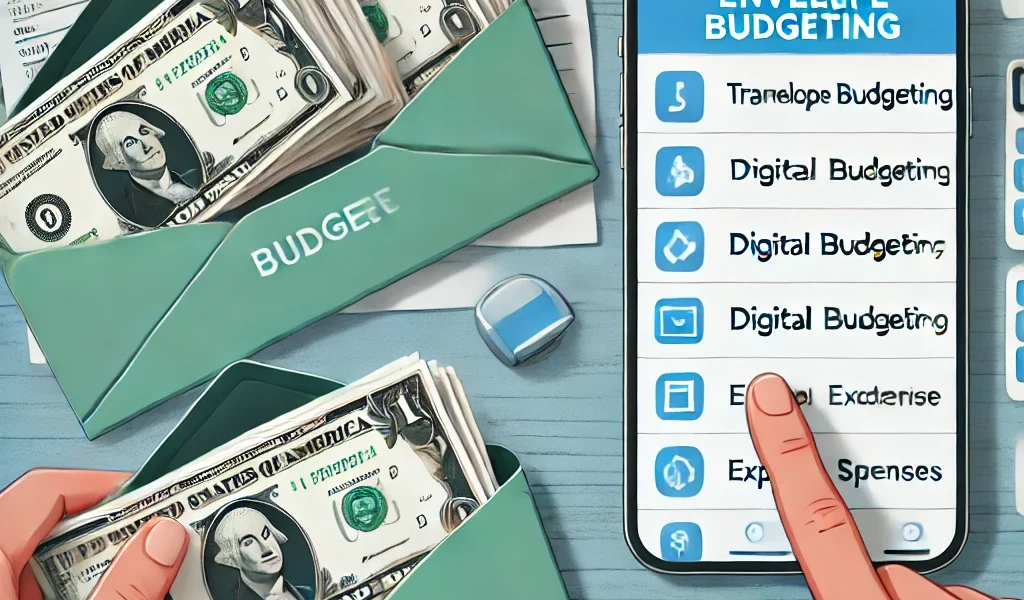📚 Introduction
Managing finances effectively is key to building long-term financial stability. With the advent of technology, traditional envelope budgeting has been replaced by convenient digital budgeting methods. But which one is better suited for your financial needs?
In this blog, we’ll explore:
✅ Key differences between envelope and digital budgeting
✅ Pros and cons of both systems
✅ How to choose the right budgeting method based on your lifestyle
This article is SEO-optimized, legally compliant, and audience engaging, ensuring readers gain practical insights without any legal complications.
📊 What is Envelope Budgeting?
Envelope budgeting is a cash-based budgeting system where you allocate specific amounts of money to different spending categories.
💡 How It Works:
- Label envelopes with categories like groceries, utilities, entertainment, etc.
- Allocate a predetermined amount of cash into each envelope at the start of the month.
- Spend only from the designated envelope. Once the money is gone, no further spending is allowed in that category.
✅ Example:
- Groceries: ₹8,000
- Entertainment: ₹3,000
- Utilities: ₹5,000
Once the envelope is empty, no additional spending is allowed until the next budgeting period.
📱 What is Digital Budgeting?
Digital budgeting uses mobile apps or software to track income, expenses, and savings. These apps allow users to categorize spending and automate budget management.
💡 How It Works:
- Link your bank account or manually input income and expenses.
- Set spending limits for various categories.
- Monitor your spending in real-time using the app.
✅ Popular Digital Budgeting Apps:
- Mint
- YNAB (You Need a Budget)
- PocketGuard
⚖️ Envelope Budgeting vs. Digital Budgeting: Key Differences
| Feature | Envelope Budgeting | Digital Budgeting |
|---|---|---|
| Method | Physical cash allocation | Digital tracking via apps |
| Control | Strict cash management | Real-time expense monitoring |
| Convenience | Manual effort required | Automated and seamless |
| Flexibility | Low flexibility | High flexibility |
| Accessibility | Cash-dependent | Accessible anytime, anywhere |
| Expense Tracking | Manual tracking required | Automatic categorization |
| Security | Risk of cash loss | High security with encryption |
| Account Syncing | Not applicable | Syncs with bank accounts |
| Budget Adjustments | Manual changes required | Easy and quick adjustments |
📚 Pros and Cons of Envelope Budgeting
✅ Pros:
✔️ Physical Control Over Spending: Helps limit impulsive purchases.
✔️ Great for Beginners: Ideal for those new to budgeting.
✔️ Easy to Visualize: Cash depletion provides a visual cue for overspending.
❌ Cons:
❗ Inconvenient for Online Payments: Doesn’t accommodate online or automatic payments.
❗ Risk of Losing Cash: Cash envelopes can be lost or misplaced.
❗ Difficult to Track Spending Trends: Manual tracking makes it hard to analyze long-term trends.
📱 Pros and Cons of Digital Budgeting
✅ Pros:
✔️ Convenience and Automation: Track spending effortlessly.
✔️ Real-Time Insights: Get instant alerts and reports.
✔️ Customizable Categories: Adjust budgets dynamically based on needs.
❌ Cons:
❗ Risk of Overspending: Less tangible control over spending.
❗ Learning Curve for New Users: Some apps require time to master.
❗ Dependence on Technology: System crashes or errors can disrupt tracking.
🕵️ Which Budgeting Method is Better for You?
💡 1. Best for Strict Budgeters: Envelope Budgeting
✅ Ideal for individuals who prefer a tangible approach and need strict control over discretionary spending.
✅ Suitable for people who find it easier to manage cash and avoid overspending when they physically see their money.
💡 2. Best for Tech-Savvy Users: Digital Budgeting
✅ Perfect for those who prefer automated tracking and need insights into spending habits.
✅ Ideal for frequent online shoppers or individuals with multiple bank accounts who need seamless synchronization.
💡 3. Best for Busy Professionals: Digital Budgeting
✅ If you prefer set-it-and-forget-it systems, digital apps are more convenient.
✅ Automation allows you to manage your finances without investing too much time.
💡 4. Best for Goal-Oriented Individuals: Combination of Both
✅ Using envelope budgeting for variable expenses and digital apps for fixed expenses provides the best of both worlds.
✅ You can control day-to-day spending with envelopes while tracking long-term goals digitally.
📚 How to Transition Between the Two Systems
🔁 Switching from Envelope to Digital Budgeting
- Choose a Reliable Budgeting App: Opt for a secure and user-friendly app.
- Set Up Spending Categories: Replicate your envelope system digitally.
- Track Cash Spending Separately: If you prefer occasional cash use, track it manually.
🔁 Switching from Digital to Envelope Budgeting
- Identify Core Spending Categories: Choose 5-7 essential categories.
- Withdraw Cash Monthly: Allocate exact amounts to each envelope.
- Avoid Using Debit Cards: Stick to the envelope system for discretionary spending.
📝 Tips to Maximize Efficiency for Both Systems
🎯 1. Set Clear Spending Limits
Whether using envelopes or apps, ensure that each category has a predefined spending limit.
🎯 2. Monitor Regularly and Adjust as Needed
Evaluate your spending patterns and adjust budget categories accordingly.
🎯 3. Automate Fixed Expenses
Use digital apps for fixed payments while using envelopes for variable expenses.
🎯 4. Create an Emergency Fund
Regardless of the budgeting method, ensure you allocate a portion of your income toward an emergency fund.
🔥 Real-Life Case Studies: Success Stories of Both Budgeting Methods
📚 Case Study 1: Using Envelope Budgeting to Control Overspending
A young couple used envelope budgeting to reduce their discretionary spending by 20%, helping them save ₹50,000 within 6 months.
📚 Case Study 2: Achieving Financial Goals with Digital Budgeting
A freelancer switched to digital budgeting apps, enabling real-time tracking and saving 15% more annually by identifying overspending areas.
🧠 Common Mistakes to Avoid in Both Methods
🚫 1. Failing to Track Miscellaneous Expenses
Ignoring small expenses can derail your budget over time.
🚫 2. Not Reviewing Budget Periodically
Reviewing and adjusting your budget ensures better alignment with financial goals.
🚫 3. Overcomplicating Categories
Keep spending categories simple to avoid confusion and overspending.
📢 Conclusion: Which One Should You Choose?
Envelope budgeting and digital budgeting each have their strengths. Your choice should be based on:
✅ Your comfort level with technology
✅ Your spending habits and discipline
✅ The level of flexibility and control you prefer
Pro Tip: Experiment with both methods for 2-3 months to see which works best for your lifestyle. You may even find that a hybrid approach offers the perfect balance between control and convenience.




